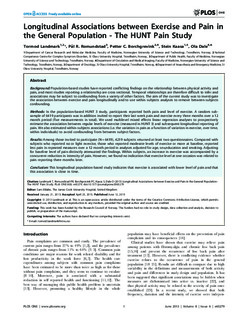| dc.contributor.author | Landmark, Tormod | |
| dc.contributor.author | Romundstad, Pål Richard | |
| dc.contributor.author | Borchgrevink, Petter Chr. | |
| dc.contributor.author | Kaasa, Stein | |
| dc.contributor.author | Dale, Ola | |
| dc.date.accessioned | 2015-11-20T10:52:44Z | |
| dc.date.accessioned | 2016-05-18T13:22:54Z | |
| dc.date.available | 2015-11-20T10:52:44Z | |
| dc.date.available | 2016-05-18T13:22:54Z | |
| dc.date.issued | 2013 | |
| dc.identifier.citation | PLoS ONE 2013, 8(6) | nb_NO |
| dc.identifier.issn | 1932-6203 | |
| dc.identifier.uri | http://hdl.handle.net/11250/2389631 | |
| dc.description.abstract | Background: Population-based studies have reported conflicting findings on the relationship between physical activity and pain, and most studies reporting a relationship are cross sectional. Temporal relationships are therefore difficult to infer and associations may be subject to confounding from a variety of other factors. The aim of the current study was to investigate the association between exercise and pain longitudinally and to use within subjects analyses to remove between subjects confounding.
Methods: In the population-based HUNT 3 study, participants reported both pain and level of exercise. A random sub-sample of 6419 participants was in addition invited to report their last week pain and exercise every three months over a 12 month period (five measurements in total). We used multilevel mixed effects linear regression analyses to prospectively estimate the association between regular levels of exercise (measured in HUNT 3) and subsequent longitudinal reporting of pain. We also estimated within-subjects associations (i.e. the variation in pain as a function of variation in exercise, over time, within individuals) to avoid confounding from between subject factors.
Results: Among those invited to participate (N = 6419), 4219 subjects returned at least two questionnaires. Compared with subjects who reported no or light exercise, those who reported moderate levels of exercise or more at baseline, reported less pain in repeated measures over a 12 month period in analyses adjusted for age, sex,education and smoking. Adjusting for baseline level of pain distinctly attenuated the findings. Within subjects, an increase in exercise was accompanied by a concurrent reduction in intensity of pain. However, we found no indication that exercise level at one occasion was related to pain reporting three months later.
Conclusion: This longitudinal population-based study indicates that exercise is associated with lower level of pain and that this association is close in time. | nb_NO |
| dc.language.iso | eng | nb_NO |
| dc.publisher | Public Library of Science | nb_NO |
| dc.rights | Navngivelse 3.0 Norge | * |
| dc.rights.uri | http://creativecommons.org/licenses/by/3.0/no/ | * |
| dc.title | Longitudinal Associations between Exercise and Pain in the General Population - The HUNT Pain Study | nb_NO |
| dc.type | Journal article | nb_NO |
| dc.type | Peer reviewed | nb_NO |
| dc.date.updated | 2015-11-20T10:52:44Z | |
| dc.source.volume | 8 | nb_NO |
| dc.source.journal | PLoS ONE | nb_NO |
| dc.source.issue | 6 | nb_NO |
| dc.identifier.doi | 10.1371/journal.pone.0065279 | |
| dc.identifier.cristin | 1047076 | |
| dc.description.localcode | © 2013 Landmark et al. This is an open-access article distributed under the terms of the Creative Commons Attribution License, which permits unrestricted use, distribution, and reproduction in any medium, provided the original author and source are credited. | nb_NO |

